BUS710 Marketing in an International Environment: Woolworths Plan
VerifiedAdded on 2023/06/03
|13
|2539
|191
Report
AI Summary
This report outlines an international marketing plan for Woolworths' entry into the Swedish market. It includes a SWOT and PESTEL analysis, product strategy focusing on cost leadership and quality, segmentation and positioning strategies targeting price-sensitive consumers, and a pricing strategy emphasizing low costs. The plan also details a direct distribution strategy and promotional activities, including TV commercials and CSR programs, to enhance brand image. The report identifies potential problems, such as competition with Aldi, and suggests solutions like reducing product lines to improve supply chain efficiency. The conclusion recommends that Woolworths focus on reducing operational costs and positively impacting its supply chain in Sweden, along with a detailed timeline for implementation. This comprehensive plan aims to guide Woolworths in establishing a successful presence in the Swedish market.
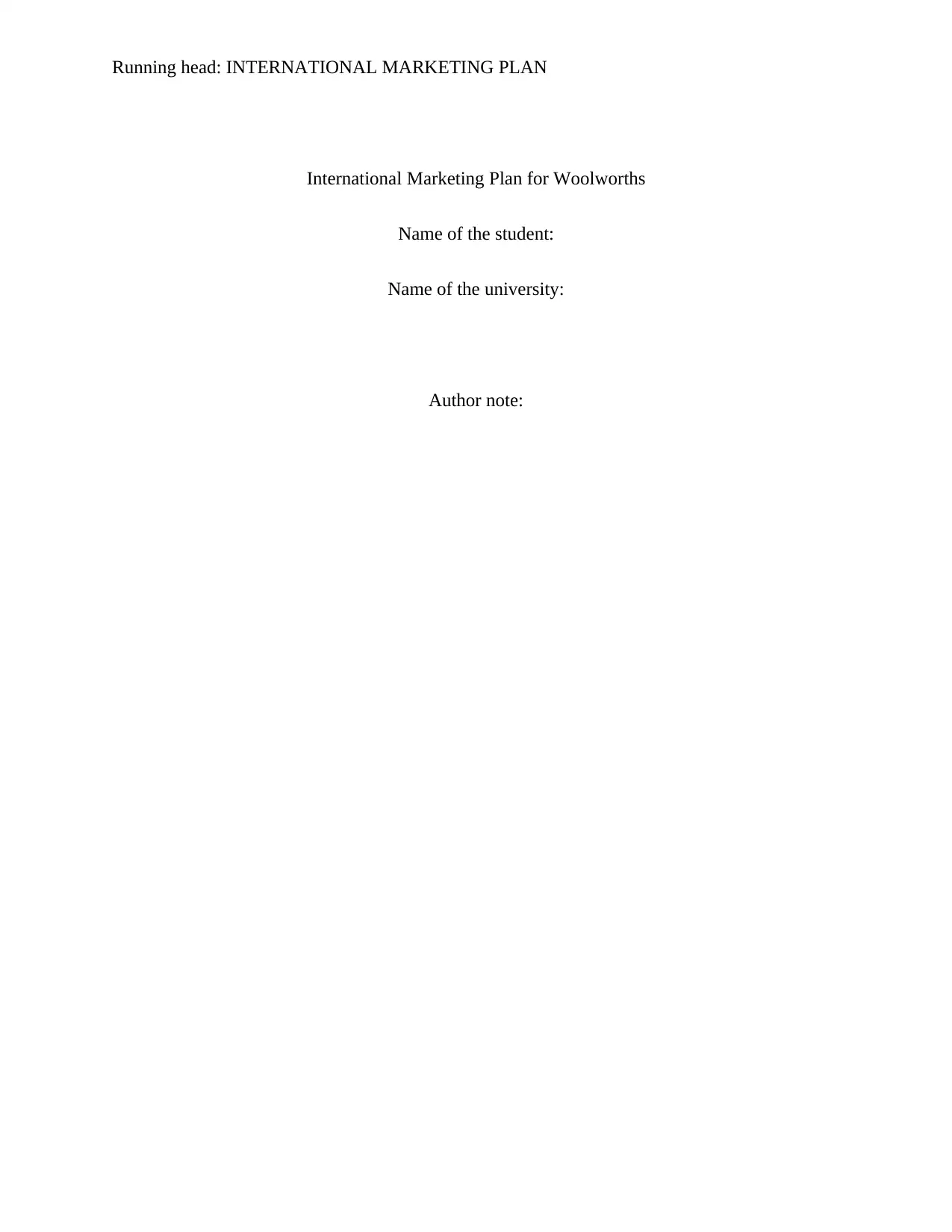
Running head: INTERNATIONAL MARKETING PLAN
International Marketing Plan for Woolworths
Name of the student:
Name of the university:
Author note:
International Marketing Plan for Woolworths
Name of the student:
Name of the university:
Author note:
Paraphrase This Document
Need a fresh take? Get an instant paraphrase of this document with our AI Paraphraser
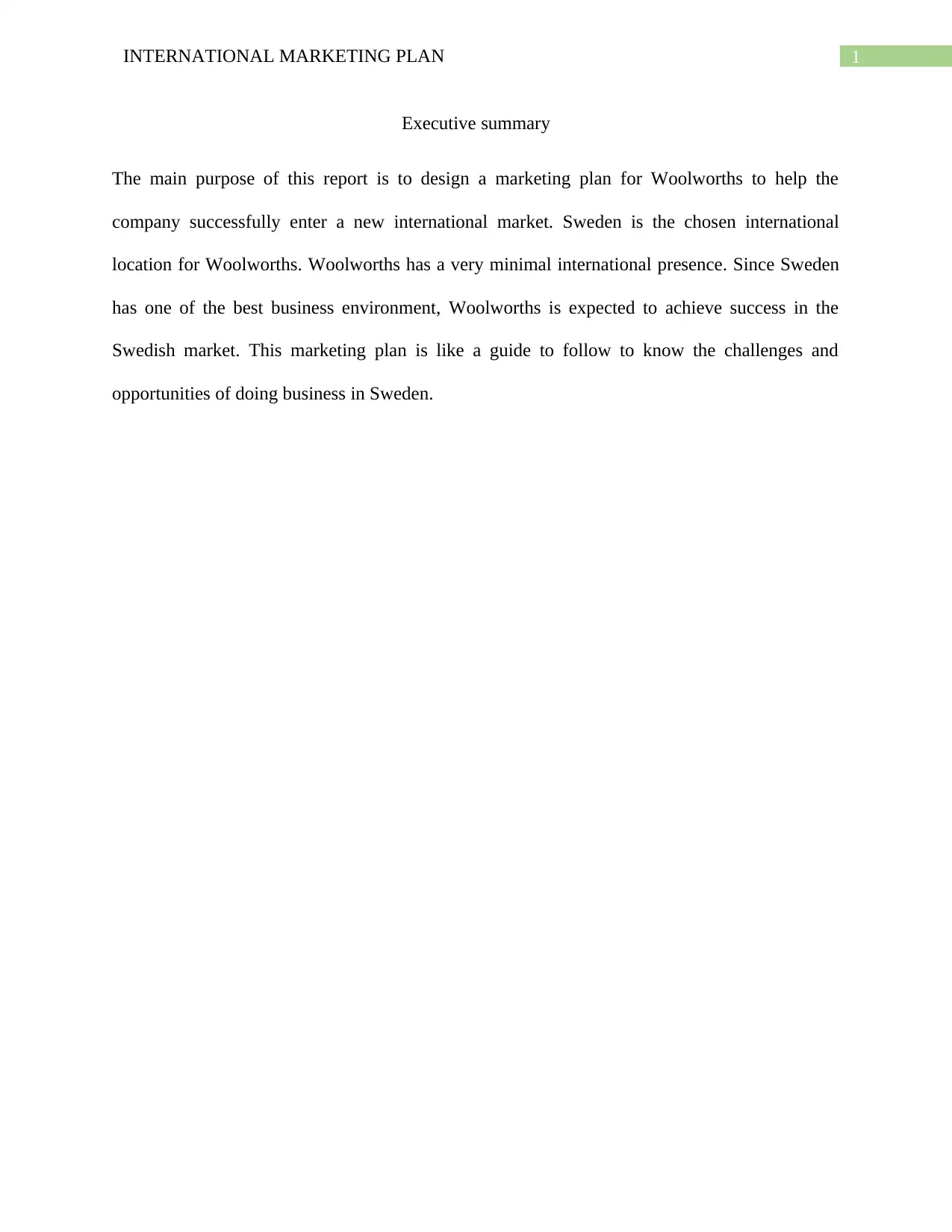
1INTERNATIONAL MARKETING PLAN
Executive summary
The main purpose of this report is to design a marketing plan for Woolworths to help the
company successfully enter a new international market. Sweden is the chosen international
location for Woolworths. Woolworths has a very minimal international presence. Since Sweden
has one of the best business environment, Woolworths is expected to achieve success in the
Swedish market. This marketing plan is like a guide to follow to know the challenges and
opportunities of doing business in Sweden.
Executive summary
The main purpose of this report is to design a marketing plan for Woolworths to help the
company successfully enter a new international market. Sweden is the chosen international
location for Woolworths. Woolworths has a very minimal international presence. Since Sweden
has one of the best business environment, Woolworths is expected to achieve success in the
Swedish market. This marketing plan is like a guide to follow to know the challenges and
opportunities of doing business in Sweden.
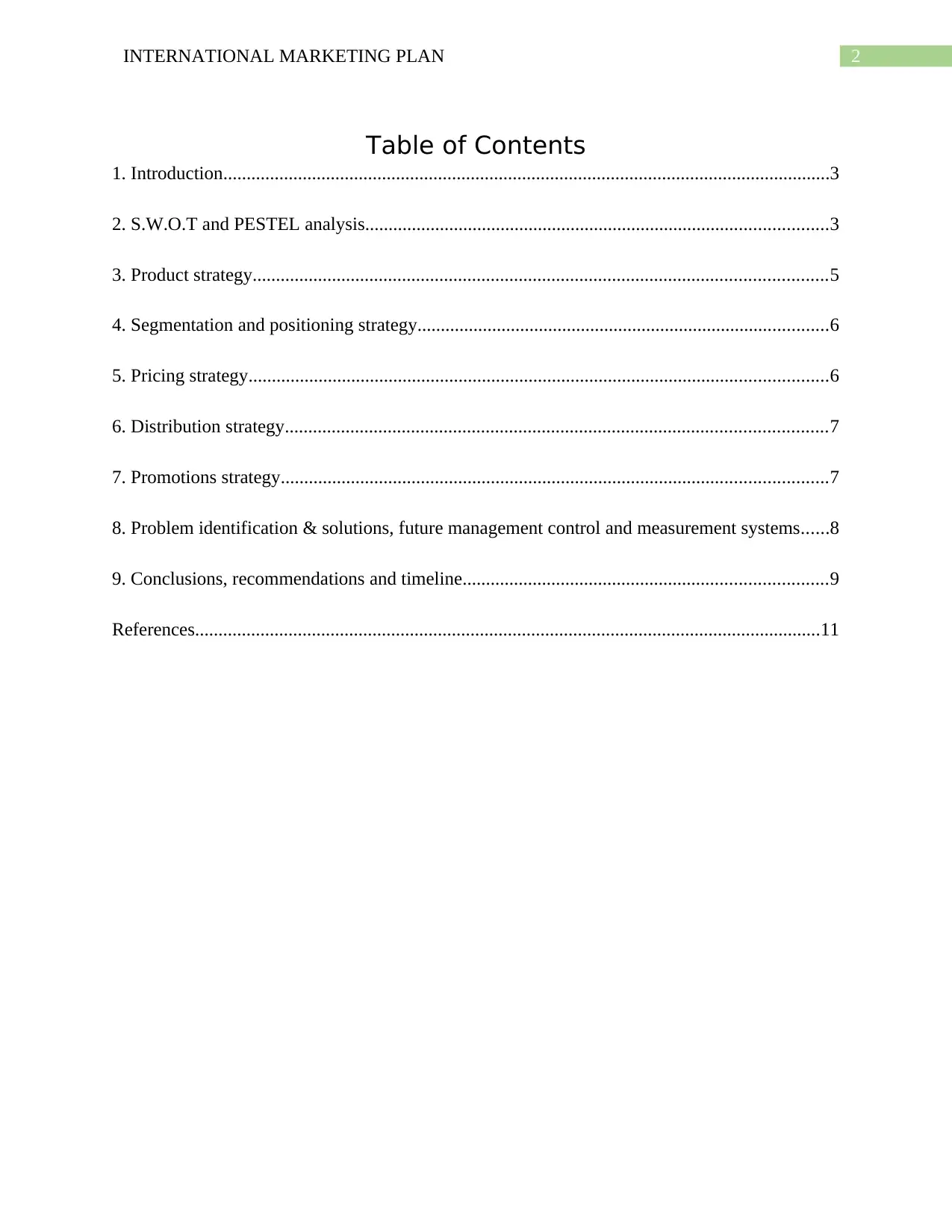
2INTERNATIONAL MARKETING PLAN
Table of Contents
1. Introduction..................................................................................................................................3
2. S.W.O.T and PESTEL analysis...................................................................................................3
3. Product strategy...........................................................................................................................5
4. Segmentation and positioning strategy........................................................................................6
5. Pricing strategy............................................................................................................................6
6. Distribution strategy....................................................................................................................7
7. Promotions strategy.....................................................................................................................7
8. Problem identification & solutions, future management control and measurement systems......8
9. Conclusions, recommendations and timeline..............................................................................9
References......................................................................................................................................11
Table of Contents
1. Introduction..................................................................................................................................3
2. S.W.O.T and PESTEL analysis...................................................................................................3
3. Product strategy...........................................................................................................................5
4. Segmentation and positioning strategy........................................................................................6
5. Pricing strategy............................................................................................................................6
6. Distribution strategy....................................................................................................................7
7. Promotions strategy.....................................................................................................................7
8. Problem identification & solutions, future management control and measurement systems......8
9. Conclusions, recommendations and timeline..............................................................................9
References......................................................................................................................................11
⊘ This is a preview!⊘
Do you want full access?
Subscribe today to unlock all pages.

Trusted by 1+ million students worldwide
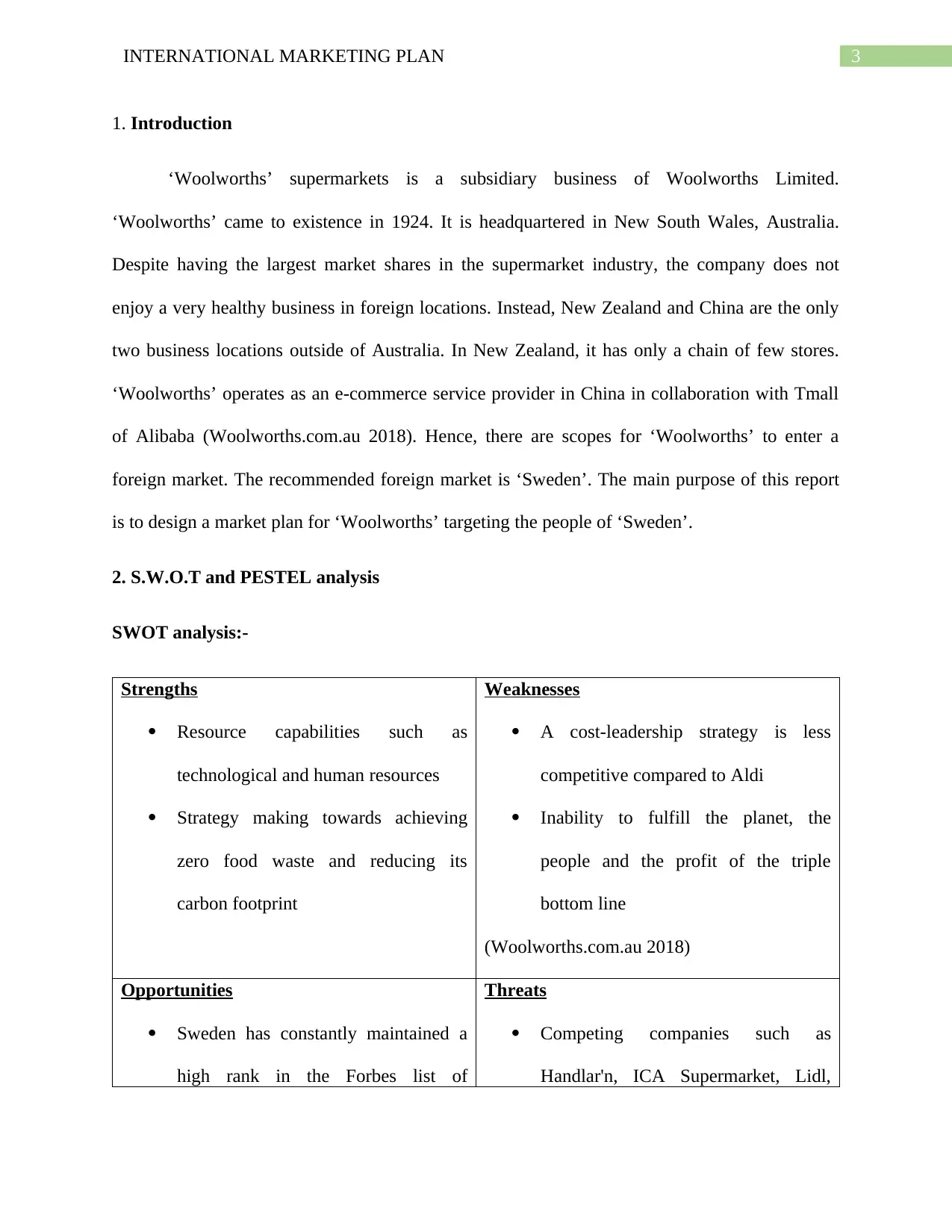
3INTERNATIONAL MARKETING PLAN
1. Introduction
‘Woolworths’ supermarkets is a subsidiary business of Woolworths Limited.
‘Woolworths’ came to existence in 1924. It is headquartered in New South Wales, Australia.
Despite having the largest market shares in the supermarket industry, the company does not
enjoy a very healthy business in foreign locations. Instead, New Zealand and China are the only
two business locations outside of Australia. In New Zealand, it has only a chain of few stores.
‘Woolworths’ operates as an e-commerce service provider in China in collaboration with Tmall
of Alibaba (Woolworths.com.au 2018). Hence, there are scopes for ‘Woolworths’ to enter a
foreign market. The recommended foreign market is ‘Sweden’. The main purpose of this report
is to design a market plan for ‘Woolworths’ targeting the people of ‘Sweden’.
2. S.W.O.T and PESTEL analysis
SWOT analysis:-
Strengths
Resource capabilities such as
technological and human resources
Strategy making towards achieving
zero food waste and reducing its
carbon footprint
Weaknesses
A cost-leadership strategy is less
competitive compared to Aldi
Inability to fulfill the planet, the
people and the profit of the triple
bottom line
(Woolworths.com.au 2018)
Opportunities
Sweden has constantly maintained a
high rank in the Forbes list of
Threats
Competing companies such as
Handlar'n, ICA Supermarket, Lidl,
1. Introduction
‘Woolworths’ supermarkets is a subsidiary business of Woolworths Limited.
‘Woolworths’ came to existence in 1924. It is headquartered in New South Wales, Australia.
Despite having the largest market shares in the supermarket industry, the company does not
enjoy a very healthy business in foreign locations. Instead, New Zealand and China are the only
two business locations outside of Australia. In New Zealand, it has only a chain of few stores.
‘Woolworths’ operates as an e-commerce service provider in China in collaboration with Tmall
of Alibaba (Woolworths.com.au 2018). Hence, there are scopes for ‘Woolworths’ to enter a
foreign market. The recommended foreign market is ‘Sweden’. The main purpose of this report
is to design a market plan for ‘Woolworths’ targeting the people of ‘Sweden’.
2. S.W.O.T and PESTEL analysis
SWOT analysis:-
Strengths
Resource capabilities such as
technological and human resources
Strategy making towards achieving
zero food waste and reducing its
carbon footprint
Weaknesses
A cost-leadership strategy is less
competitive compared to Aldi
Inability to fulfill the planet, the
people and the profit of the triple
bottom line
(Woolworths.com.au 2018)
Opportunities
Sweden has constantly maintained a
high rank in the Forbes list of
Threats
Competing companies such as
Handlar'n, ICA Supermarket, Lidl,
Paraphrase This Document
Need a fresh take? Get an instant paraphrase of this document with our AI Paraphraser
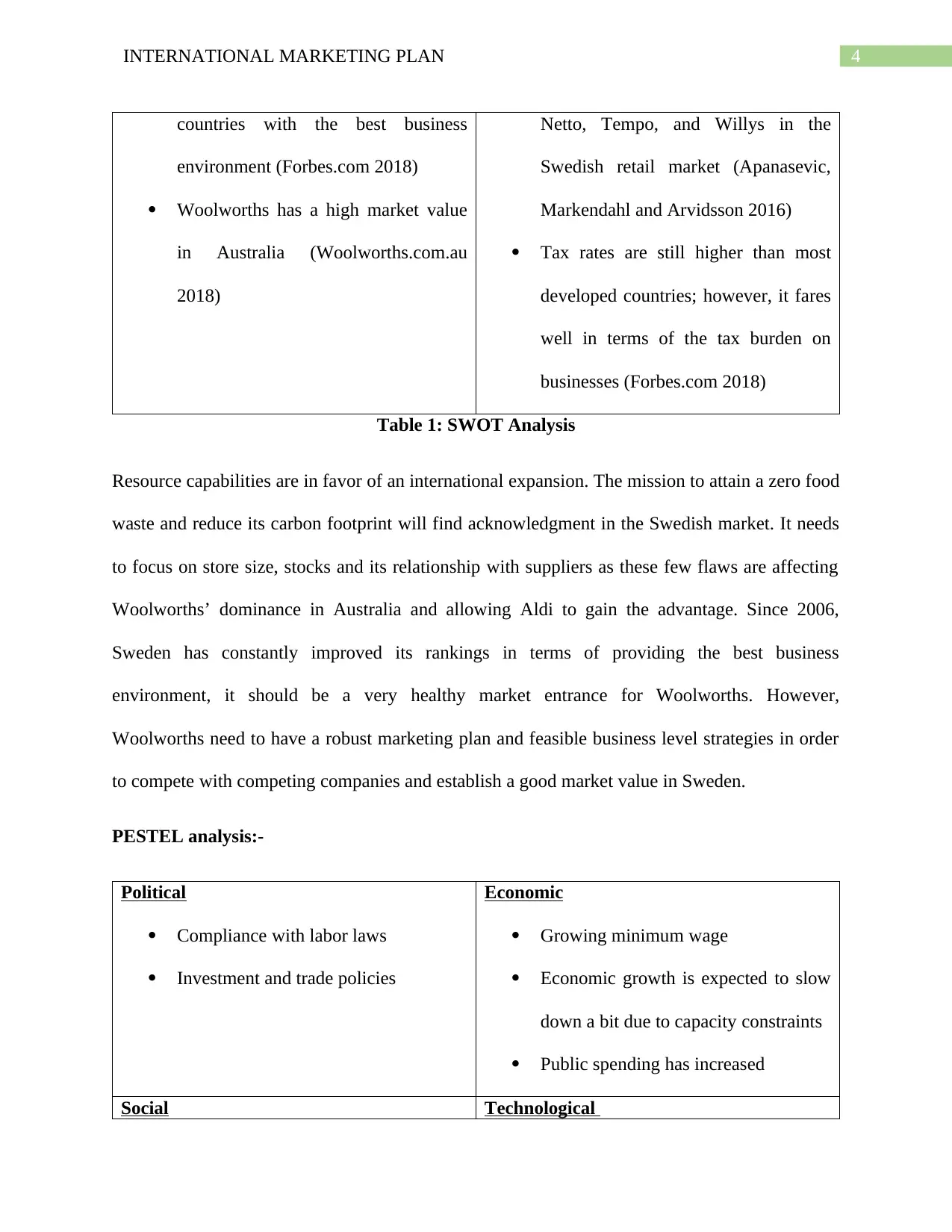
4INTERNATIONAL MARKETING PLAN
countries with the best business
environment (Forbes.com 2018)
Woolworths has a high market value
in Australia (Woolworths.com.au
2018)
Netto, Tempo, and Willys in the
Swedish retail market (Apanasevic,
Markendahl and Arvidsson 2016)
Tax rates are still higher than most
developed countries; however, it fares
well in terms of the tax burden on
businesses (Forbes.com 2018)
Table 1: SWOT Analysis
Resource capabilities are in favor of an international expansion. The mission to attain a zero food
waste and reduce its carbon footprint will find acknowledgment in the Swedish market. It needs
to focus on store size, stocks and its relationship with suppliers as these few flaws are affecting
Woolworths’ dominance in Australia and allowing Aldi to gain the advantage. Since 2006,
Sweden has constantly improved its rankings in terms of providing the best business
environment, it should be a very healthy market entrance for Woolworths. However,
Woolworths need to have a robust marketing plan and feasible business level strategies in order
to compete with competing companies and establish a good market value in Sweden.
PESTEL analysis:-
Political
Compliance with labor laws
Investment and trade policies
Economic
Growing minimum wage
Economic growth is expected to slow
down a bit due to capacity constraints
Public spending has increased
Social Technological
countries with the best business
environment (Forbes.com 2018)
Woolworths has a high market value
in Australia (Woolworths.com.au
2018)
Netto, Tempo, and Willys in the
Swedish retail market (Apanasevic,
Markendahl and Arvidsson 2016)
Tax rates are still higher than most
developed countries; however, it fares
well in terms of the tax burden on
businesses (Forbes.com 2018)
Table 1: SWOT Analysis
Resource capabilities are in favor of an international expansion. The mission to attain a zero food
waste and reduce its carbon footprint will find acknowledgment in the Swedish market. It needs
to focus on store size, stocks and its relationship with suppliers as these few flaws are affecting
Woolworths’ dominance in Australia and allowing Aldi to gain the advantage. Since 2006,
Sweden has constantly improved its rankings in terms of providing the best business
environment, it should be a very healthy market entrance for Woolworths. However,
Woolworths need to have a robust marketing plan and feasible business level strategies in order
to compete with competing companies and establish a good market value in Sweden.
PESTEL analysis:-
Political
Compliance with labor laws
Investment and trade policies
Economic
Growing minimum wage
Economic growth is expected to slow
down a bit due to capacity constraints
Public spending has increased
Social Technological
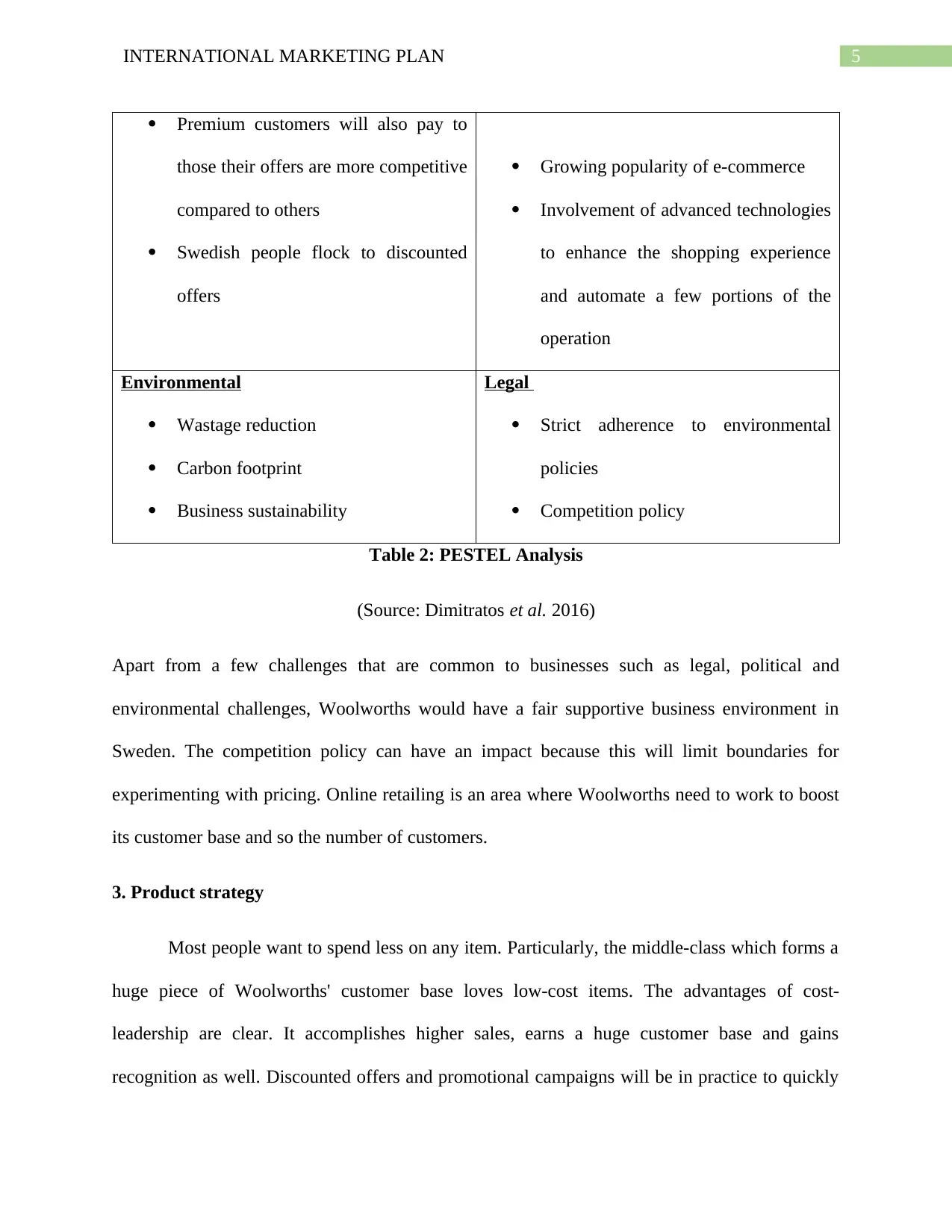
5INTERNATIONAL MARKETING PLAN
Premium customers will also pay to
those their offers are more competitive
compared to others
Swedish people flock to discounted
offers
Growing popularity of e-commerce
Involvement of advanced technologies
to enhance the shopping experience
and automate a few portions of the
operation
Environmental
Wastage reduction
Carbon footprint
Business sustainability
Legal
Strict adherence to environmental
policies
Competition policy
Table 2: PESTEL Analysis
(Source: Dimitratos et al. 2016)
Apart from a few challenges that are common to businesses such as legal, political and
environmental challenges, Woolworths would have a fair supportive business environment in
Sweden. The competition policy can have an impact because this will limit boundaries for
experimenting with pricing. Online retailing is an area where Woolworths need to work to boost
its customer base and so the number of customers.
3. Product strategy
Most people want to spend less on any item. Particularly, the middle-class which forms a
huge piece of Woolworths' customer base loves low-cost items. The advantages of cost-
leadership are clear. It accomplishes higher sales, earns a huge customer base and gains
recognition as well. Discounted offers and promotional campaigns will be in practice to quickly
Premium customers will also pay to
those their offers are more competitive
compared to others
Swedish people flock to discounted
offers
Growing popularity of e-commerce
Involvement of advanced technologies
to enhance the shopping experience
and automate a few portions of the
operation
Environmental
Wastage reduction
Carbon footprint
Business sustainability
Legal
Strict adherence to environmental
policies
Competition policy
Table 2: PESTEL Analysis
(Source: Dimitratos et al. 2016)
Apart from a few challenges that are common to businesses such as legal, political and
environmental challenges, Woolworths would have a fair supportive business environment in
Sweden. The competition policy can have an impact because this will limit boundaries for
experimenting with pricing. Online retailing is an area where Woolworths need to work to boost
its customer base and so the number of customers.
3. Product strategy
Most people want to spend less on any item. Particularly, the middle-class which forms a
huge piece of Woolworths' customer base loves low-cost items. The advantages of cost-
leadership are clear. It accomplishes higher sales, earns a huge customer base and gains
recognition as well. Discounted offers and promotional campaigns will be in practice to quickly
⊘ This is a preview!⊘
Do you want full access?
Subscribe today to unlock all pages.

Trusted by 1+ million students worldwide
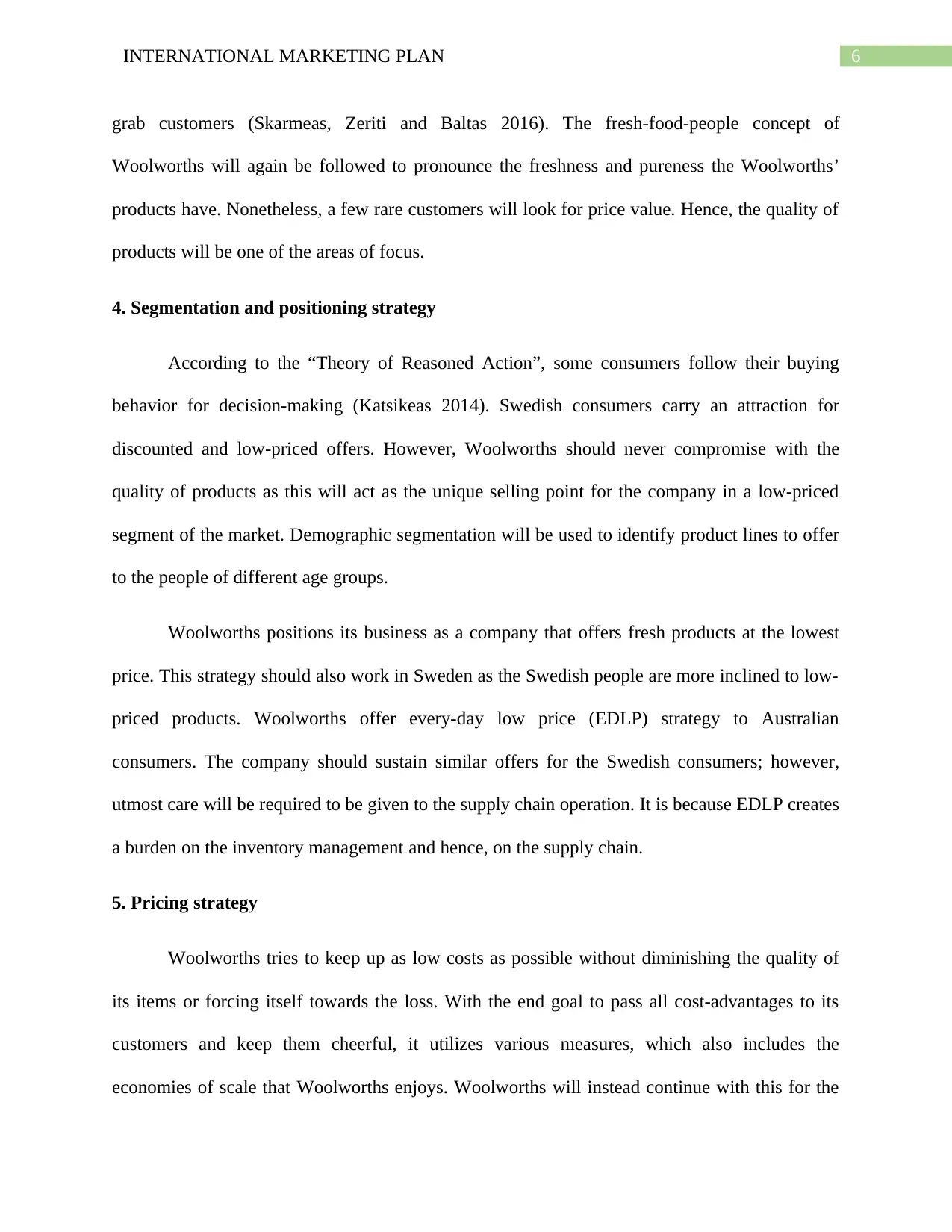
6INTERNATIONAL MARKETING PLAN
grab customers (Skarmeas, Zeriti and Baltas 2016). The fresh-food-people concept of
Woolworths will again be followed to pronounce the freshness and pureness the Woolworths’
products have. Nonetheless, a few rare customers will look for price value. Hence, the quality of
products will be one of the areas of focus.
4. Segmentation and positioning strategy
According to the “Theory of Reasoned Action”, some consumers follow their buying
behavior for decision-making (Katsikeas 2014). Swedish consumers carry an attraction for
discounted and low-priced offers. However, Woolworths should never compromise with the
quality of products as this will act as the unique selling point for the company in a low-priced
segment of the market. Demographic segmentation will be used to identify product lines to offer
to the people of different age groups.
Woolworths positions its business as a company that offers fresh products at the lowest
price. This strategy should also work in Sweden as the Swedish people are more inclined to low-
priced products. Woolworths offer every-day low price (EDLP) strategy to Australian
consumers. The company should sustain similar offers for the Swedish consumers; however,
utmost care will be required to be given to the supply chain operation. It is because EDLP creates
a burden on the inventory management and hence, on the supply chain.
5. Pricing strategy
Woolworths tries to keep up as low costs as possible without diminishing the quality of
its items or forcing itself towards the loss. With the end goal to pass all cost-advantages to its
customers and keep them cheerful, it utilizes various measures, which also includes the
economies of scale that Woolworths enjoys. Woolworths will instead continue with this for the
grab customers (Skarmeas, Zeriti and Baltas 2016). The fresh-food-people concept of
Woolworths will again be followed to pronounce the freshness and pureness the Woolworths’
products have. Nonetheless, a few rare customers will look for price value. Hence, the quality of
products will be one of the areas of focus.
4. Segmentation and positioning strategy
According to the “Theory of Reasoned Action”, some consumers follow their buying
behavior for decision-making (Katsikeas 2014). Swedish consumers carry an attraction for
discounted and low-priced offers. However, Woolworths should never compromise with the
quality of products as this will act as the unique selling point for the company in a low-priced
segment of the market. Demographic segmentation will be used to identify product lines to offer
to the people of different age groups.
Woolworths positions its business as a company that offers fresh products at the lowest
price. This strategy should also work in Sweden as the Swedish people are more inclined to low-
priced products. Woolworths offer every-day low price (EDLP) strategy to Australian
consumers. The company should sustain similar offers for the Swedish consumers; however,
utmost care will be required to be given to the supply chain operation. It is because EDLP creates
a burden on the inventory management and hence, on the supply chain.
5. Pricing strategy
Woolworths tries to keep up as low costs as possible without diminishing the quality of
its items or forcing itself towards the loss. With the end goal to pass all cost-advantages to its
customers and keep them cheerful, it utilizes various measures, which also includes the
economies of scale that Woolworths enjoys. Woolworths will instead continue with this for the
Paraphrase This Document
Need a fresh take? Get an instant paraphrase of this document with our AI Paraphraser
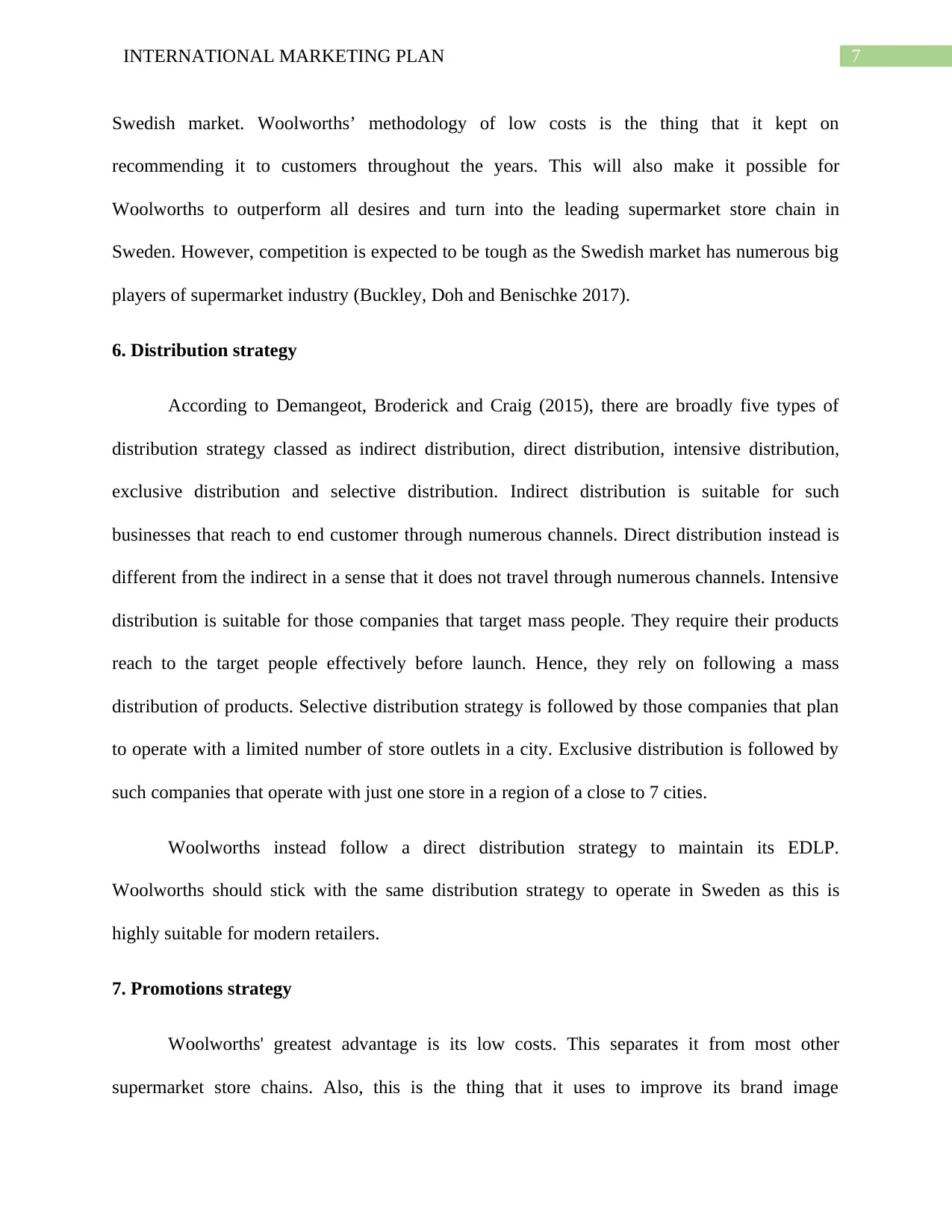
7INTERNATIONAL MARKETING PLAN
Swedish market. Woolworths’ methodology of low costs is the thing that it kept on
recommending it to customers throughout the years. This will also make it possible for
Woolworths to outperform all desires and turn into the leading supermarket store chain in
Sweden. However, competition is expected to be tough as the Swedish market has numerous big
players of supermarket industry (Buckley, Doh and Benischke 2017).
6. Distribution strategy
According to Demangeot, Broderick and Craig (2015), there are broadly five types of
distribution strategy classed as indirect distribution, direct distribution, intensive distribution,
exclusive distribution and selective distribution. Indirect distribution is suitable for such
businesses that reach to end customer through numerous channels. Direct distribution instead is
different from the indirect in a sense that it does not travel through numerous channels. Intensive
distribution is suitable for those companies that target mass people. They require their products
reach to the target people effectively before launch. Hence, they rely on following a mass
distribution of products. Selective distribution strategy is followed by those companies that plan
to operate with a limited number of store outlets in a city. Exclusive distribution is followed by
such companies that operate with just one store in a region of a close to 7 cities.
Woolworths instead follow a direct distribution strategy to maintain its EDLP.
Woolworths should stick with the same distribution strategy to operate in Sweden as this is
highly suitable for modern retailers.
7. Promotions strategy
Woolworths' greatest advantage is its low costs. This separates it from most other
supermarket store chains. Also, this is the thing that it uses to improve its brand image
Swedish market. Woolworths’ methodology of low costs is the thing that it kept on
recommending it to customers throughout the years. This will also make it possible for
Woolworths to outperform all desires and turn into the leading supermarket store chain in
Sweden. However, competition is expected to be tough as the Swedish market has numerous big
players of supermarket industry (Buckley, Doh and Benischke 2017).
6. Distribution strategy
According to Demangeot, Broderick and Craig (2015), there are broadly five types of
distribution strategy classed as indirect distribution, direct distribution, intensive distribution,
exclusive distribution and selective distribution. Indirect distribution is suitable for such
businesses that reach to end customer through numerous channels. Direct distribution instead is
different from the indirect in a sense that it does not travel through numerous channels. Intensive
distribution is suitable for those companies that target mass people. They require their products
reach to the target people effectively before launch. Hence, they rely on following a mass
distribution of products. Selective distribution strategy is followed by those companies that plan
to operate with a limited number of store outlets in a city. Exclusive distribution is followed by
such companies that operate with just one store in a region of a close to 7 cities.
Woolworths instead follow a direct distribution strategy to maintain its EDLP.
Woolworths should stick with the same distribution strategy to operate in Sweden as this is
highly suitable for modern retailers.
7. Promotions strategy
Woolworths' greatest advantage is its low costs. This separates it from most other
supermarket store chains. Also, this is the thing that it uses to improve its brand image
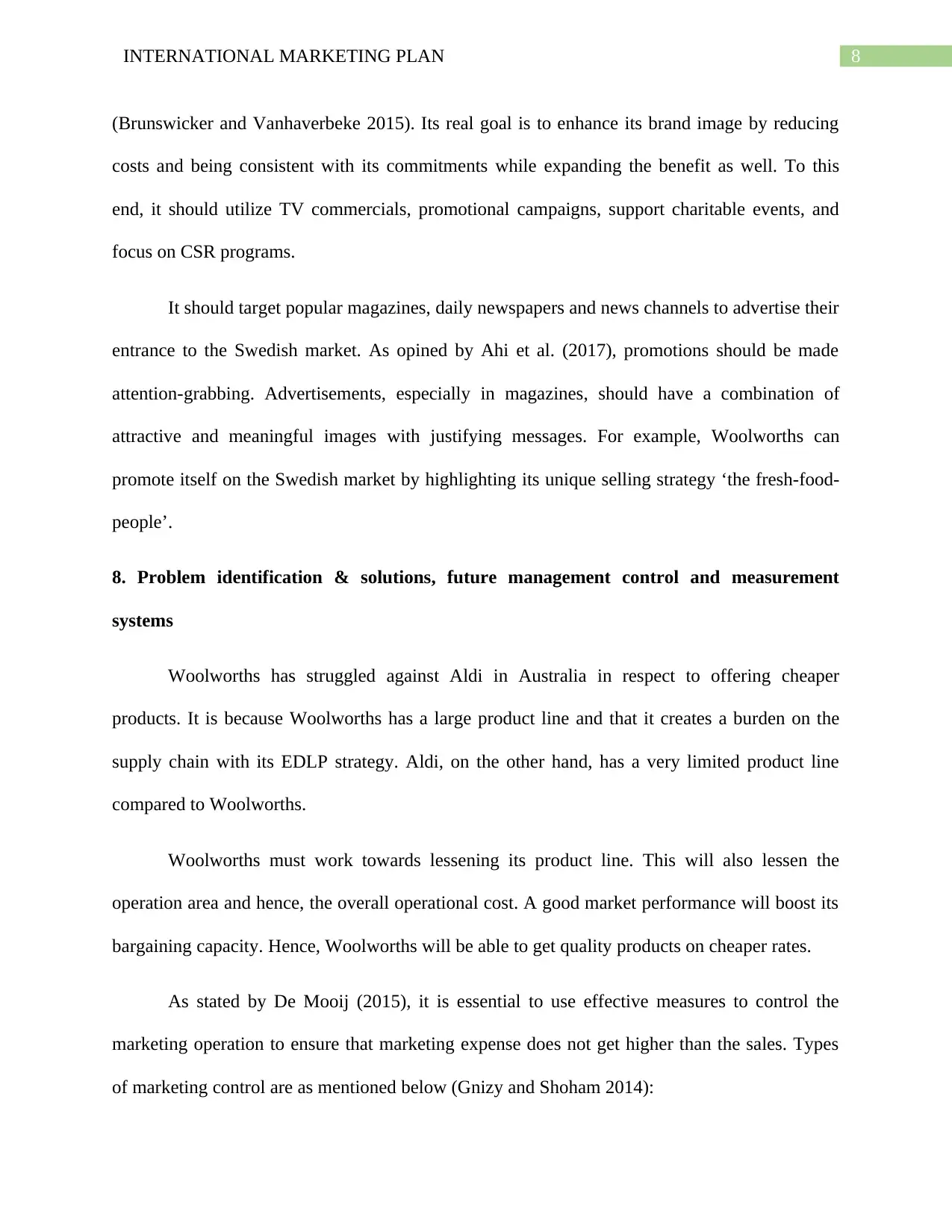
8INTERNATIONAL MARKETING PLAN
(Brunswicker and Vanhaverbeke 2015). Its real goal is to enhance its brand image by reducing
costs and being consistent with its commitments while expanding the benefit as well. To this
end, it should utilize TV commercials, promotional campaigns, support charitable events, and
focus on CSR programs.
It should target popular magazines, daily newspapers and news channels to advertise their
entrance to the Swedish market. As opined by Ahi et al. (2017), promotions should be made
attention-grabbing. Advertisements, especially in magazines, should have a combination of
attractive and meaningful images with justifying messages. For example, Woolworths can
promote itself on the Swedish market by highlighting its unique selling strategy ‘the fresh-food-
people’.
8. Problem identification & solutions, future management control and measurement
systems
Woolworths has struggled against Aldi in Australia in respect to offering cheaper
products. It is because Woolworths has a large product line and that it creates a burden on the
supply chain with its EDLP strategy. Aldi, on the other hand, has a very limited product line
compared to Woolworths.
Woolworths must work towards lessening its product line. This will also lessen the
operation area and hence, the overall operational cost. A good market performance will boost its
bargaining capacity. Hence, Woolworths will be able to get quality products on cheaper rates.
As stated by De Mooij (2015), it is essential to use effective measures to control the
marketing operation to ensure that marketing expense does not get higher than the sales. Types
of marketing control are as mentioned below (Gnizy and Shoham 2014):
(Brunswicker and Vanhaverbeke 2015). Its real goal is to enhance its brand image by reducing
costs and being consistent with its commitments while expanding the benefit as well. To this
end, it should utilize TV commercials, promotional campaigns, support charitable events, and
focus on CSR programs.
It should target popular magazines, daily newspapers and news channels to advertise their
entrance to the Swedish market. As opined by Ahi et al. (2017), promotions should be made
attention-grabbing. Advertisements, especially in magazines, should have a combination of
attractive and meaningful images with justifying messages. For example, Woolworths can
promote itself on the Swedish market by highlighting its unique selling strategy ‘the fresh-food-
people’.
8. Problem identification & solutions, future management control and measurement
systems
Woolworths has struggled against Aldi in Australia in respect to offering cheaper
products. It is because Woolworths has a large product line and that it creates a burden on the
supply chain with its EDLP strategy. Aldi, on the other hand, has a very limited product line
compared to Woolworths.
Woolworths must work towards lessening its product line. This will also lessen the
operation area and hence, the overall operational cost. A good market performance will boost its
bargaining capacity. Hence, Woolworths will be able to get quality products on cheaper rates.
As stated by De Mooij (2015), it is essential to use effective measures to control the
marketing operation to ensure that marketing expense does not get higher than the sales. Types
of marketing control are as mentioned below (Gnizy and Shoham 2014):
⊘ This is a preview!⊘
Do you want full access?
Subscribe today to unlock all pages.

Trusted by 1+ million students worldwide
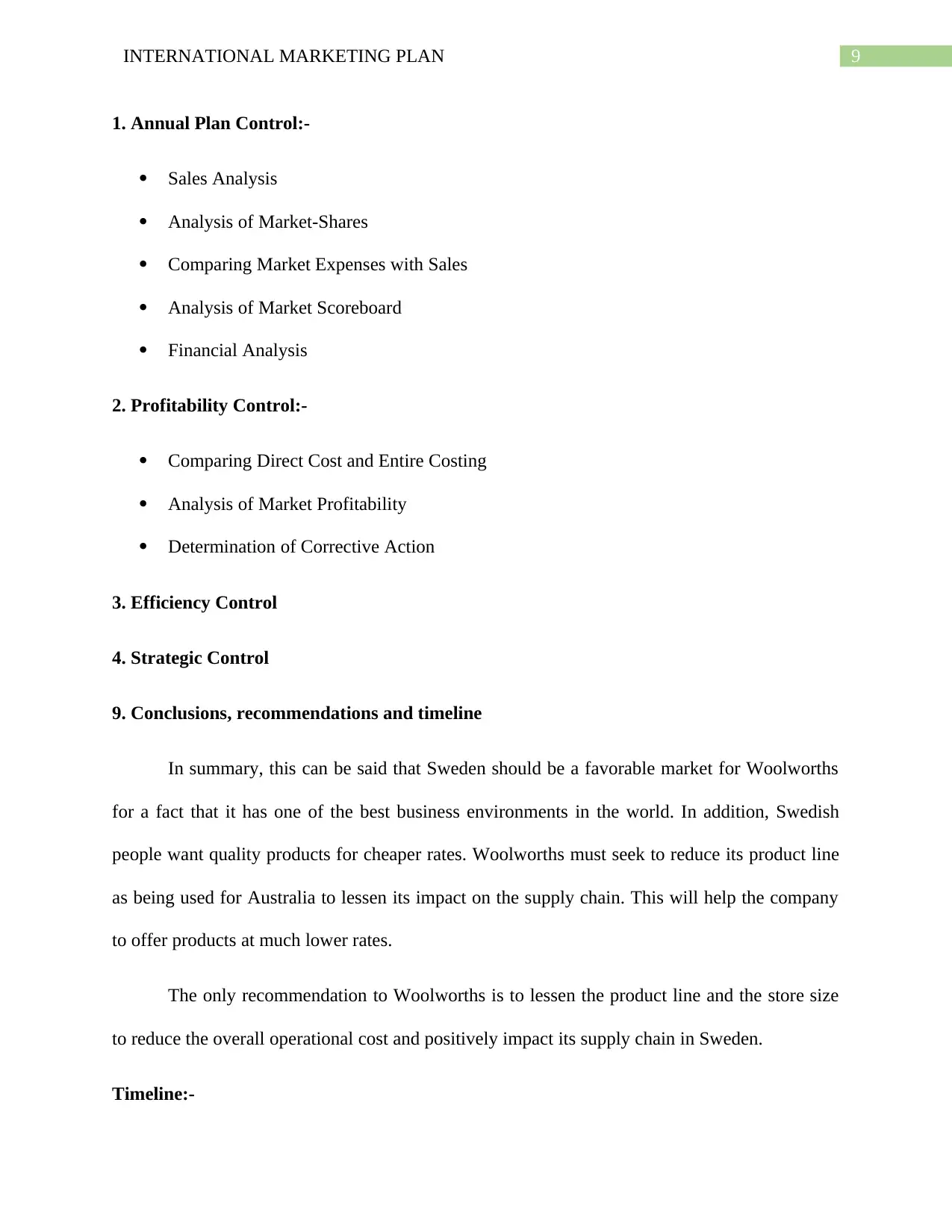
9INTERNATIONAL MARKETING PLAN
1. Annual Plan Control:-
Sales Analysis
Analysis of Market-Shares
Comparing Market Expenses with Sales
Analysis of Market Scoreboard
Financial Analysis
2. Profitability Control:-
Comparing Direct Cost and Entire Costing
Analysis of Market Profitability
Determination of Corrective Action
3. Efficiency Control
4. Strategic Control
9. Conclusions, recommendations and timeline
In summary, this can be said that Sweden should be a favorable market for Woolworths
for a fact that it has one of the best business environments in the world. In addition, Swedish
people want quality products for cheaper rates. Woolworths must seek to reduce its product line
as being used for Australia to lessen its impact on the supply chain. This will help the company
to offer products at much lower rates.
The only recommendation to Woolworths is to lessen the product line and the store size
to reduce the overall operational cost and positively impact its supply chain in Sweden.
Timeline:-
1. Annual Plan Control:-
Sales Analysis
Analysis of Market-Shares
Comparing Market Expenses with Sales
Analysis of Market Scoreboard
Financial Analysis
2. Profitability Control:-
Comparing Direct Cost and Entire Costing
Analysis of Market Profitability
Determination of Corrective Action
3. Efficiency Control
4. Strategic Control
9. Conclusions, recommendations and timeline
In summary, this can be said that Sweden should be a favorable market for Woolworths
for a fact that it has one of the best business environments in the world. In addition, Swedish
people want quality products for cheaper rates. Woolworths must seek to reduce its product line
as being used for Australia to lessen its impact on the supply chain. This will help the company
to offer products at much lower rates.
The only recommendation to Woolworths is to lessen the product line and the store size
to reduce the overall operational cost and positively impact its supply chain in Sweden.
Timeline:-
Paraphrase This Document
Need a fresh take? Get an instant paraphrase of this document with our AI Paraphraser
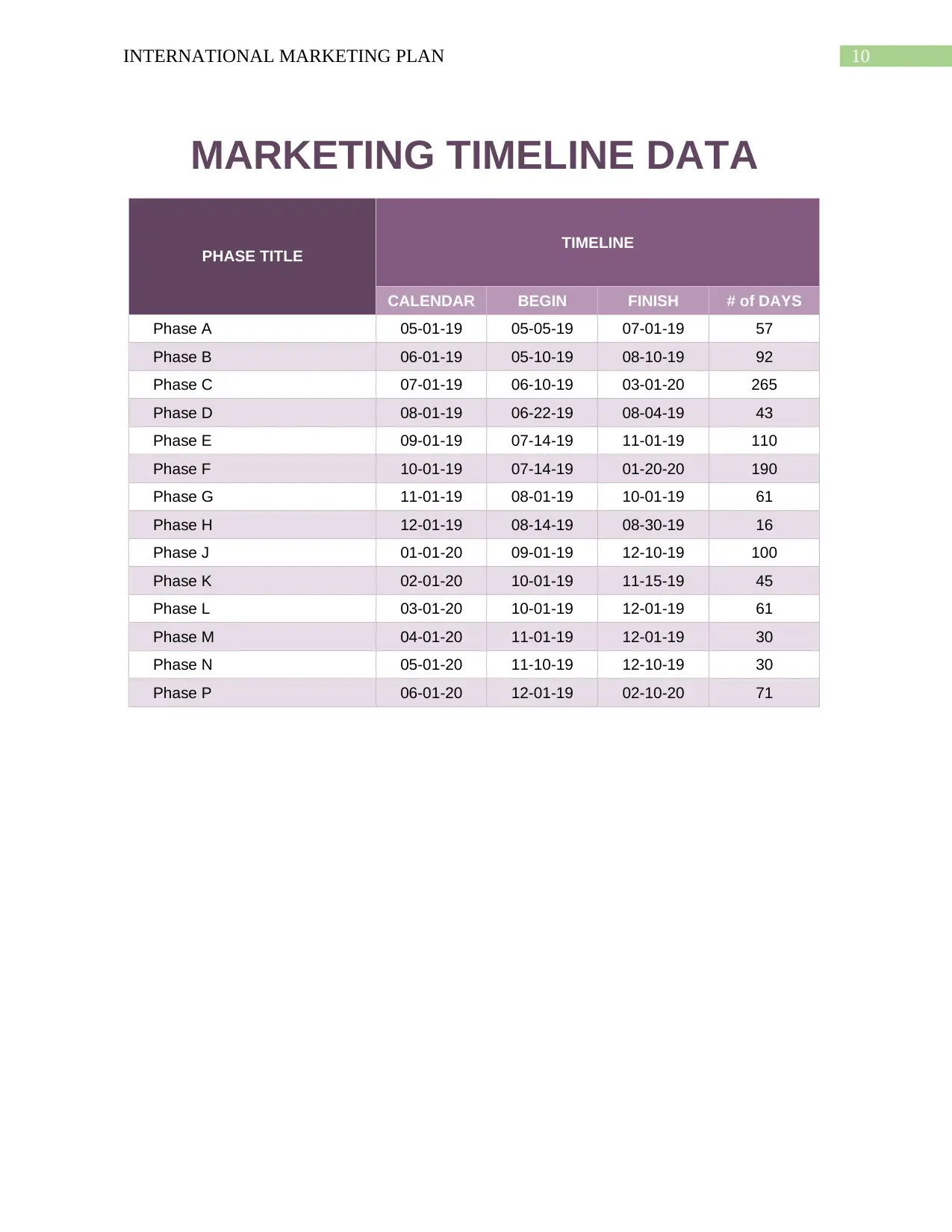
10INTERNATIONAL MARKETING PLAN
MARKETING TIMELINE DATA
PHASE TITLE TIMELINE
CALENDAR BEGIN FINISH # of DAYS
Phase A 05-01-19 05-05-19 07-01-19 57
Phase B 06-01-19 05-10-19 08-10-19 92
Phase C 07-01-19 06-10-19 03-01-20 265
Phase D 08-01-19 06-22-19 08-04-19 43
Phase E 09-01-19 07-14-19 11-01-19 110
Phase F 10-01-19 07-14-19 01-20-20 190
Phase G 11-01-19 08-01-19 10-01-19 61
Phase H 12-01-19 08-14-19 08-30-19 16
Phase J 01-01-20 09-01-19 12-10-19 100
Phase K 02-01-20 10-01-19 11-15-19 45
Phase L 03-01-20 10-01-19 12-01-19 61
Phase M 04-01-20 11-01-19 12-01-19 30
Phase N 05-01-20 11-10-19 12-10-19 30
Phase P 06-01-20 12-01-19 02-10-20 71
MARKETING TIMELINE DATA
PHASE TITLE TIMELINE
CALENDAR BEGIN FINISH # of DAYS
Phase A 05-01-19 05-05-19 07-01-19 57
Phase B 06-01-19 05-10-19 08-10-19 92
Phase C 07-01-19 06-10-19 03-01-20 265
Phase D 08-01-19 06-22-19 08-04-19 43
Phase E 09-01-19 07-14-19 11-01-19 110
Phase F 10-01-19 07-14-19 01-20-20 190
Phase G 11-01-19 08-01-19 10-01-19 61
Phase H 12-01-19 08-14-19 08-30-19 16
Phase J 01-01-20 09-01-19 12-10-19 100
Phase K 02-01-20 10-01-19 11-15-19 45
Phase L 03-01-20 10-01-19 12-01-19 61
Phase M 04-01-20 11-01-19 12-01-19 30
Phase N 05-01-20 11-10-19 12-10-19 30
Phase P 06-01-20 12-01-19 02-10-20 71
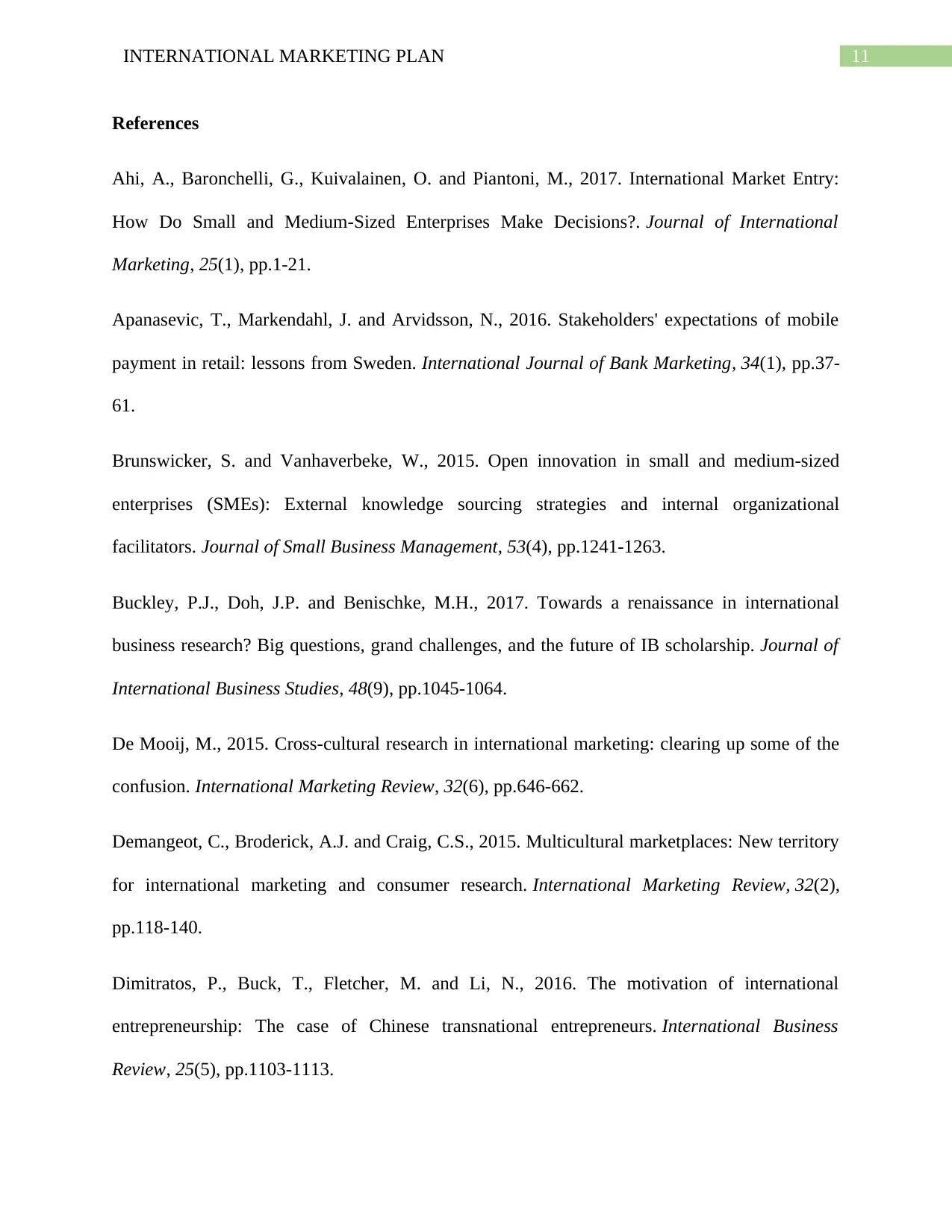
11INTERNATIONAL MARKETING PLAN
References
Ahi, A., Baronchelli, G., Kuivalainen, O. and Piantoni, M., 2017. International Market Entry:
How Do Small and Medium-Sized Enterprises Make Decisions?. Journal of International
Marketing, 25(1), pp.1-21.
Apanasevic, T., Markendahl, J. and Arvidsson, N., 2016. Stakeholders' expectations of mobile
payment in retail: lessons from Sweden. International Journal of Bank Marketing, 34(1), pp.37-
61.
Brunswicker, S. and Vanhaverbeke, W., 2015. Open innovation in small and medium‐sized
enterprises (SMEs): External knowledge sourcing strategies and internal organizational
facilitators. Journal of Small Business Management, 53(4), pp.1241-1263.
Buckley, P.J., Doh, J.P. and Benischke, M.H., 2017. Towards a renaissance in international
business research? Big questions, grand challenges, and the future of IB scholarship. Journal of
International Business Studies, 48(9), pp.1045-1064.
De Mooij, M., 2015. Cross-cultural research in international marketing: clearing up some of the
confusion. International Marketing Review, 32(6), pp.646-662.
Demangeot, C., Broderick, A.J. and Craig, C.S., 2015. Multicultural marketplaces: New territory
for international marketing and consumer research. International Marketing Review, 32(2),
pp.118-140.
Dimitratos, P., Buck, T., Fletcher, M. and Li, N., 2016. The motivation of international
entrepreneurship: The case of Chinese transnational entrepreneurs. International Business
Review, 25(5), pp.1103-1113.
References
Ahi, A., Baronchelli, G., Kuivalainen, O. and Piantoni, M., 2017. International Market Entry:
How Do Small and Medium-Sized Enterprises Make Decisions?. Journal of International
Marketing, 25(1), pp.1-21.
Apanasevic, T., Markendahl, J. and Arvidsson, N., 2016. Stakeholders' expectations of mobile
payment in retail: lessons from Sweden. International Journal of Bank Marketing, 34(1), pp.37-
61.
Brunswicker, S. and Vanhaverbeke, W., 2015. Open innovation in small and medium‐sized
enterprises (SMEs): External knowledge sourcing strategies and internal organizational
facilitators. Journal of Small Business Management, 53(4), pp.1241-1263.
Buckley, P.J., Doh, J.P. and Benischke, M.H., 2017. Towards a renaissance in international
business research? Big questions, grand challenges, and the future of IB scholarship. Journal of
International Business Studies, 48(9), pp.1045-1064.
De Mooij, M., 2015. Cross-cultural research in international marketing: clearing up some of the
confusion. International Marketing Review, 32(6), pp.646-662.
Demangeot, C., Broderick, A.J. and Craig, C.S., 2015. Multicultural marketplaces: New territory
for international marketing and consumer research. International Marketing Review, 32(2),
pp.118-140.
Dimitratos, P., Buck, T., Fletcher, M. and Li, N., 2016. The motivation of international
entrepreneurship: The case of Chinese transnational entrepreneurs. International Business
Review, 25(5), pp.1103-1113.
⊘ This is a preview!⊘
Do you want full access?
Subscribe today to unlock all pages.

Trusted by 1+ million students worldwide
1 out of 13
Related Documents
Your All-in-One AI-Powered Toolkit for Academic Success.
+13062052269
info@desklib.com
Available 24*7 on WhatsApp / Email
![[object Object]](/_next/static/media/star-bottom.7253800d.svg)
Unlock your academic potential
Copyright © 2020–2025 A2Z Services. All Rights Reserved. Developed and managed by ZUCOL.




